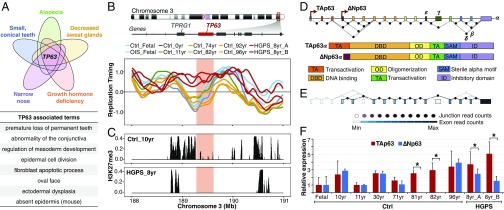Fig. 3.
The TP63 gene is a marker of HGPS. (A) Overlap analysis of the genes within GO terms reveals TP63 as unique gene linked with the progeroid phenotypic characteristics. Additional GO terms annotated for the E-progeria RT signature and linked to TP63 abnormalities are shown in the table. (B) TP63 replicates early in progeria cells but late in all fibroblasts derived from healthy donors as well as in cells entering senescence. (C) Loss of H3K27me3 peaks at the TP63 gene in HGPS cells (cell line HGADFN167 = HGPS_8yr). A healthy donor of similar age is shown. (H3K27me3 datasets were obtained from ref. 18.) (D) TP63 exon organization and functional domains. (E) Skin tissue from healthy donors predominantly expresses ∆Np63 isoforms. Exon and junction RNA-seq expression levels are color-coded according to read numbers. (F) Isoform-specific expression analysis by qRT-PCR demonstrates an altered ratio of TP63 variants expression in HGPS. Relative expression was normalized against HPRT1 gene and fetal fibroblasts. Significant differences are shown (*P < 0.05).

